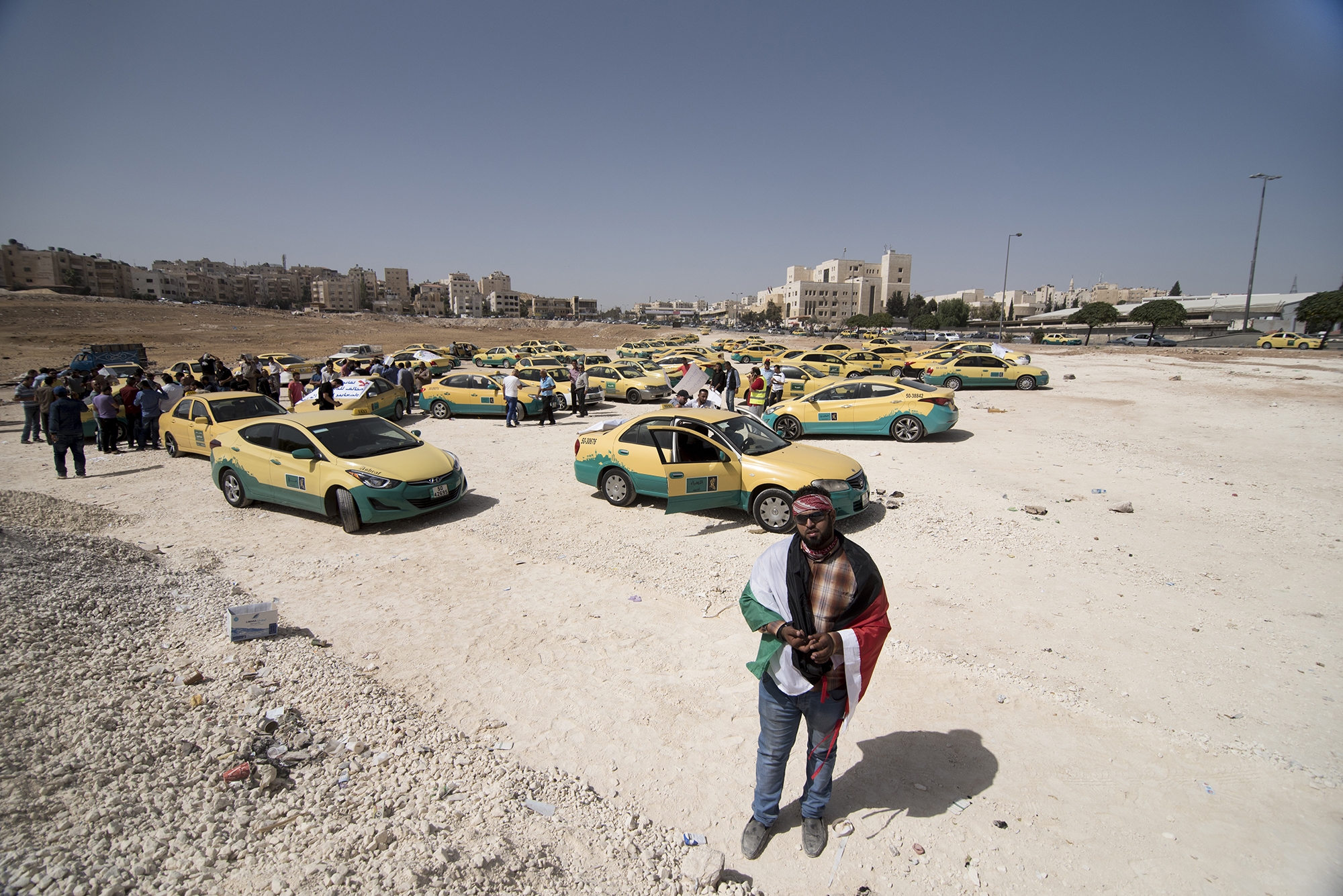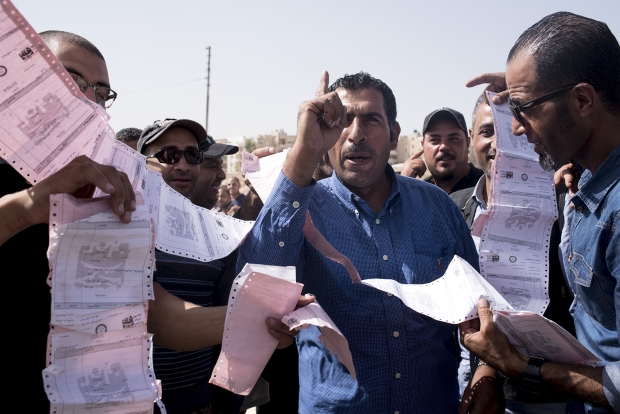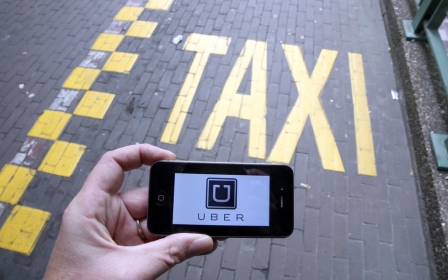Taxis, Uber and Amman’s transportation conundrum

AMMAN, Jordan - A bobblehead doll wobbles on the dashboard of a yellow cab as we lurch forward in the stop and start traffic that dominates central Amman at 5pm.
Blaring horns cut through Arabic music playing on the radio and a cloud of cigarette smoke engulfs the front seat. Between sips of coffee, the driver yells his way through a phone call. He bows his head as we zoom past small crowds with raised hands on the sidewalk, hoping to catch an empty car.
This chaotic hustle is just a part of everyday life. With almost 11,000 roaming the streets today, yellow cabs are by far the most available form of transportation for Amman’s four million residents. But their ubiquity does not always translate to quality. Commuters have long complained of drivers routinely demanding bloated fares or refusing rides altogether to traffic-heavy areas of the city.
Still, the capital’s scant public transportation system traditionally meant that people without cars of their own were left with few alternatives. Though buses and shared, single-route taxis run through select areas of the city, commutes from business districts to residential neighbourhoods are almost exclusively the domain of yellow cabs.
Ride-hailing companies Uber and UAE-based Careem made their Jordan debuts in 2015, frustrated riders saw new horizons. But they have also drawn the ire of Amman’s municipal officials and a yellow cab industry that’s gotten used to being the only game in town.
Rising costs, steady taximeter
Tensions came to a head again this month, when on 10 October yellow taxi drivers packed into a dirt lot to call for higher taximeter pricing, clear contracts, and perhaps most urgently, the downfall of ride-hailing apps in Jordan.
Driver Ayman al-Zaid stood in the centre of the small crowd, a megaphone in hand, shouting demands towards the Ministry of Transportation office across the street.
“The meter is not equal to our needs, it is so low,” he says. “We must pay for our children’s schools, for our families’ food and for our cars.”
Zaid’s yellow cab first hit the streets 25 years ago. Back then, he said meters started at $0.20, only 15 US cents below the current starting rate of $0.35. Today, taxis earn only three US cents per hundred metres and four for every minute of the ride.
Despite Amman’s increasingly congested bustle, the pricing system means most rides do not cost more than a few dollars in Amman. To make ends-meet, Zaid says drivers strive to get jobs taking customers longer distances like the airport or the country’s touristic sites.
“You don’t find the good customers since Uber and Careem came,” Zaid says. “If you ask a taxi driver these days when they last caught a ride to the airport, most will tell you it’s been at least two months.”
Taxis as public transportation
The battle waged by Amman taxis is hardly unique. Ride-hailing services have been a sticking point and urban planning headache in metropoles across the world. In early October, thousands of taxi drivers stopped airport traffic in Lisbon protesting plans by the Portuguese government to regulate Uber and its competitors.
However, the controversy in Jordan is also fuelled by deeper development issues.
“Part of the reason why services like Uber and Careem are so successful in Amman is the lack of a proper public transportation system,” says Hazem Zureiqat, a Jordan-based transport consultant. “If such a system were in place, taxis would be used differently - not as a commuter mode as they are today - and thus, the ‘competition’ Uber and Careem is creating would be viewed with a different lens."
But as Ayman Smadi, the transport and traffic management director for the Greater Amman Municipality (GAM), explains, a market-driven licensing system also means taxi drivers face more base costs than people realise.
“If I, for example, own a licensed taxi, most of the time I don’t drive it,” he says. “Instead, someone else comes and pays me a monthly fee [for the medallion]; they also pay for their licensing fee, the fuel, the maintenance and the [traffic] tickets.”
There are 16,000 taxis registered across Jordan, according to Smadi’s figures, the majority of which are yellow cabs. The drivers on the road today pay not for the car itself, but the taxi medallion attached to it.
GAM stopped issuing medallions in 2008 amid a saturated market, shooting their value through the roof. Hopeful drivers now pay as much as $91,000 for existing medallions, along with annual fees of around $425 to renew their own licenses as operators.
Hopeful drivers now pay as much as $91,000 for existing medallions, along with annual fees of around $425 to renew their own licenses as operators.
“Jordanians have already invested so much [into taxis], the reality is that sometimes several family members will get together and invest in a taxi permit as their only source of income,” he says. “So you can’t just say, ‘forget them'.”
Residents favour taxi alternatives
Since their introduction last year, both Uber and Careem have operated under a legal grey area in Jordan. In November 2015, the government issued a formal letter asking car rental companies in Amman - the primary source for cars used by ride-hailing apps - to avoid renting to drivers.
Traffic police have since followed-up with two crackdowns, the latest of which was this October. Cars seen operating as ride-hailing services were pulled over and their cars impounded, with drivers threatened with fines and further punishments if caught again. Local media reported some 100 cars were affected.
For Amman residents, it sparked a fresh outcry about the need for taxi alternatives.
“I guess my stories aren’t especially scarring, but they’re enough that I really prefer taking Uber or Careem over what I’ve gone through taking regular yellow cabs,” Amman resident Yara Hindawi says. “Taxis will always stop you and ask where you want to go and then respond that they want five [Jordanian] dinar for the ride or that it’s not on their way.”
Other situations have been been more uncomfortable.
“I’ve been cursed out in a cab for wearing a sleeveless top,” she says. “I don’t understand why anyone thinks he could say this in a cab.”
She says this month’s impounding round has many residents siding with ride-hailing services.
“Taxi drivers don’t offer good service for the money you pay and people are fed up,” she says. “It’s frustrating to see a crackdown [on Uber and Careem] because it leaves us with no other options, and it’s not like the public transportation services are so reliable.”
Smadi admits the process of filing complaints against taxis is not clear-cut.
“A passenger can take down the license plate number and GAM calls the driver in and gives him a warning, maybe a ticket, but clearly we’re not doing enough of this,” he says, referring to the lengthy process of having to prove an offence was committed.
Smadi says bureaucratic red-tape means complaints sometimes don’t make it very far.
“Refusing to serve a customer is punishable, there are fines and warnings up to withdrawing their license,” he says. “But I have to admit to you, this does not happen.”
Searching for middle ground
Despite nominal measures by traffic police and ongoing protests from cab drivers, a concrete plan to regulate or expel Uber and Careem has so far been elusive - but discussions are ongoing.
Shaden Abdellatif, Uber’s MENA communications manager, says these talks are aimed at finding where - and how - ride-hailing services fit in Jordan.
“It's not about not having Uber in Amman, but how they can all work together,” she says. “Obviously these are long conversations that are ongoing, but they are going well.”
Other companies are also offering alternatives.
Brazil-based Easy Taxi launched in Jordan in 2013 and allows users to request rides from participating taxis with their smartphone. Jordan marketing manager Hasan Abughosh says the company could jumpstart cab conditions for both passengers and the drivers who’ve already invested.
“The image of conventional taxis is related to bad experiences in peoples’ minds because sometimes you will find a really bad cab with a really bad driver,” he says. “We take the drivers and cabs already there [on the road] and work on evolving this.”
Meters on enrolled taxis start at a higher rate than street pickups - $0.71, up from $0.35. Drivers also get higher fares during peak hours, so time spent in traffic is taken into account.
The company estimates it now works with 80 percent of Amman’s yellow cabs. Drivers interested in joining their fleet must uphold company standards, from maintaining the cab to reliably responding to requests. Passengers review drivers using a similar system to the one Uber and Careem also use.
Meanwhile, government officials mull their own middle ground.
Smadi says Easy Taxi is among several companies being considered to partner with transportation authorities to develop a far-reaching smart system to better regulate taxi activity and provide a database to report complaints. He also believes the threat of ride-hailing takeovers could be used to GAM’s advantage.
After fuel and paying rent to his cab’s owner, he’s lucky if he walks away with $20. From food to rent, Amman is only getting more expensive.
“I want to use these services as a catalyst to reform the 11,000 taxis [in Amman], rather than discard them,” he said.
On another congested afternoon in Amman, taxi driver Mohammad Abu Saleem lets out an exasperated sigh. Even before the advent of Uber and Careem, he says he was working 14-hour shifts to make a profit. After fuel and paying rent to his cab’s owner, he’s lucky if he walks away with $20. From food to rent, he says, Amman is only getting more expensive.
“Would you believe that I see my wife for half an hour every day?” he says, shaking his head. “I’ve got five kids and I cannot support them driving this taxi anymore.”
New MEE newsletter: Jerusalem Dispatch
Sign up to get the latest insights and analysis on Israel-Palestine, alongside Turkey Unpacked and other MEE newsletters
Middle East Eye delivers independent and unrivalled coverage and analysis of the Middle East, North Africa and beyond. To learn more about republishing this content and the associated fees, please fill out this form. More about MEE can be found here.





